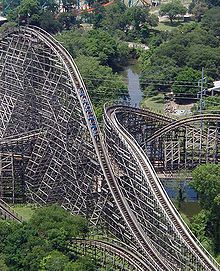
Back Kinetiese energie Afrikaans طاقة حركية Arabic গতি শক্তি Assamese Enerxía cinético AST Kinetik enerji Azerbaijani Enerhiyang kinetika BCL Кінетычная энергія Byelorussian Кінэтычная энэргія BE-X-OLD Кинетична енергия Bulgarian গতিশক্তি Bengali/Bangla
| Kinetic energy | |
|---|---|
 The cars of a roller coaster reach their maximum kinetic energy when at the bottom of the path. When they start rising, the kinetic energy begins to be converted to gravitational potential energy. The sum of kinetic and potential energy in the system remains constant, ignoring losses to friction. | |
Common symbols | KE, Ek, K or T |
| SI unit | joule (J) |
Derivations from other quantities | Ek = 1/2mv2 Ek = Et + Er |
| Part of a series on |
| Classical mechanics |
|---|

In physics, the kinetic energy of an object is the form of energy that it possesses due to its motion.[1]
In classical mechanics, the kinetic energy of a non-rotating object of mass m traveling at a speed v is .[2]
It can be shown that the kinetic energy of an object is equal to the work needed to accelerate an object of mass m from rest to its stated velocity. Having gained this energy during its acceleration, the object maintains this kinetic energy unless its speed changes. The same amount of work is done by the object when decelerating from its current speed to a state of rest.[2]
The SI unit of kinetic energy is the joule, while the English unit of kinetic energy is the foot-pound.
In relativistic mechanics, is a good approximation of kinetic energy only when v is much less than the speed of light.
- ^ Jain, Mahesh C. (2009). Textbook of Engineering Physics (Part I). PHI Learning Pvt. p. 9. ISBN 978-81-203-3862-3. Archived from the original on 2020-08-04. Retrieved 2018-06-21., Chapter 1, p. 9 Archived 2020-08-04 at the Wayback Machine
- ^ a b Resnick, Robert and Halliday, David (1960) Physics, Section 7-5, Wiley International Edition
© MMXXIII Rich X Search. We shall prevail. All rights reserved. Rich X Search


